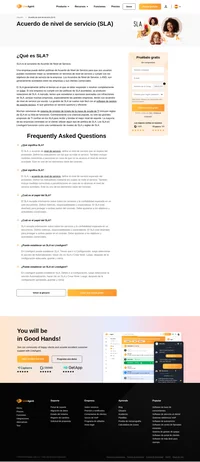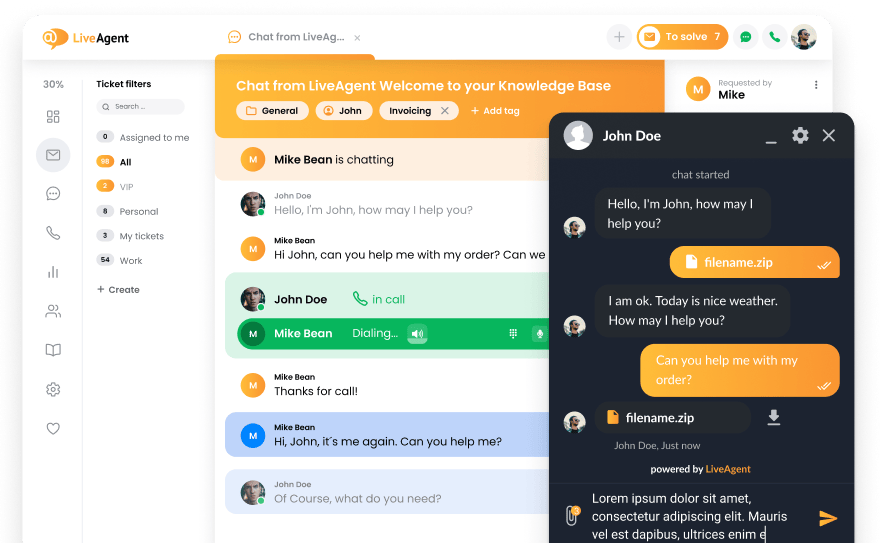¿Qué es la violación de los acuerdos de nivel de servicio (SLAs)?
Algunas empresas prefieren o están obligadas a tener un cierto acuerdo de nivel de servicio. El SLA establece un plazo de tiempo definido en el que los tickets tienen que ser contestados y lo mismo ocurre con el chat y las llamadas. Si no son contestadas o recogidas dentro del plazo especificado, se producirá una violación del SLA.
Normalmente, si se producen demasiadas violaciones de los acuerdos de nivel de servicio, una empresa debería reconsiderar sus preferencias en los SLAs o debería tener un personal de más agentes o mejores herramientas de asistencia técnica.
Una violación de SLA, también conocida como incumplimiento de SLA, ocurre cuando un proveedor de servicios no cumple con los términos establecidos en un Acuerdo de Nivel de Servicio. Esto puede incluir no cumplir con los tiempos de respuesta especificados, no alcanzar los niveles de rendimiento del servicio acordados o no adherirse a los estándares de calidad. Por ejemplo, si un SLA especifica una garantía de tiempo de actividad del 99%, cualquier tiempo de inactividad más allá de este umbral constituiría una violación. Según TechTarget, los SLA sirven como una medida crítica del rendimiento de un proveedor de servicios y son esenciales para relaciones justas entre clientes y proveedores.
Tipos de violaciones del SLA
Performance-Based Violations: These occur when the service provider fails to meet the performance metrics outlined in the SLA, such as system uptime or data processing speed. For instance, in IT services, a server downtime exceeding the allowed limit is a performance-based violation.
Response Time Violations: These occur when the service provider fails to respond to customer inquiries or issues within the agreed-upon timeframe. This is particularly critical in customer support services where delayed responses can lead to customer dissatisfaction.
Service Availability Violations: These occur when the service is unavailable or down for longer than the time specified in the SLA. This type of violation is common in telecommunications and cloud services where continuous availability is crucial.
Quality Violations: These occur when the quality of the service provided does not meet the standards outlined in the SLA. For example, if a cloud service provider offers a certain level of data redundancy and fails to deliver, it constitutes a quality violation.
Consecuencias de las violaciones del SLA
Las violaciones de SLA pueden tener consecuencias graves, incluyendo:
Financial Penalties: Many SLAs include penalty clauses that require the service provider to compensate the customer financially for any violations. This could be in the form of service credits or monetary compensation. Financial repercussions can significantly impact a provider’s profitability and financial stability.
Loss of Customer Trust: SLA violations can erode customer trust, leading to a potential loss of business and damaged relationships. Trust is a key component in customer retention and loyalty.
Reputational Damage: Frequent or significant SLA violations can damage the service provider’s reputation, affecting future partnerships and customer acquisitions. In today’s digital age, reputational damage can spread quickly and have long-lasting effects.
Operational Disruptions: Violations can lead to disruptions in business operations, especially if the service is critical to the customer’s business processes. This can result in lost productivity and additional costs for the customer.
Prevención de violaciones de SLA
Prevenir violaciones del SLA implica una combinación de planificación estratégica, soluciones tecnológicas y gestión proactiva:
Crafting Data-Driven SLAs: Develop SLAs that are realistic and data-driven, ensuring that both parties understand the expectations and limitations. This involves analyzing historical performance data to set achievable targets.
Implementing Monitoring Systems: Use automated tools to continuously monitor service performance and detect potential issues before they lead to violations. Technologies like AI and machine learning can predict and prevent potential breaches.
Establishing Alerts: Set up alerts to notify the service provider of any potential breaches, allowing for immediate action to rectify the situation. Real-time alerts enable quick responses to emerging problems.
Enhancing Communication: Maintain open communication with customers to manage expectations and address any concerns promptly. Effective communication can mitigate issues before they escalate into violations.
Developing Contingency Plans: Have contingency plans in place to quickly address and resolve any breaches that do occur. These plans ensure that service disruptions are minimized and customer impact is reduced.
Pasos a seguir si ocurre una violación de SLA
Identify the Violation: Clearly define the nature and extent of the violation by reviewing the SLA terms and performance data. Accurate identification is necessary for appropriate resolution.
Notify the Customer: Communicate with the customer promptly to inform them of the breach and the steps being taken to resolve it. Transparency is crucial in maintaining trust.
Document the Incident: Keep detailed records of the violation, including the date, time, and circumstances. Documentation is vital for accountability and future reference.
Implement a Resolution Plan: Work with the customer to develop a plan to address the breach and prevent future occurrences. Collaborative problem-solving enhances customer satisfaction.
Review and Adjust SLAs: Post-incident, review the SLA terms to identify any necessary adjustments and prevent similar issues in the future. Continuous improvement of SLAs is key to long-term success.
Causas Comunes de Violaciones de SLA
Inadequate Staffing: Insufficient staff to handle service demands can lead to delayed responses and missed performance targets. Proper workforce management is crucial for SLA compliance.
Poor Communication: Lack of clear communication between service provider and customers can lead to misunderstandings and unmet expectations. Effective communication strategies are essential.
Unexpected Events: Natural disasters, technical failures, or other unforeseen events can disrupt service and lead to violations. Preparedness and risk management help in mitigating these risks.
Inadequate Monitoring: Without proper monitoring, potential issues may go unnoticed until they result in a breach. Comprehensive monitoring systems are necessary for proactive management.
Ambiguous SLA Terms: Vague or poorly defined SLA terms can lead to misunderstandings and challenges in measuring compliance. Clarity in SLA documentation ensures mutual understanding.
Mejorando la Satisfacción del Cliente y el Rendimiento del Servicio
Enhancing Customer Experience: Utilize customer feedback to refine SLA targets and improve service delivery. Customer-centric approaches lead to better satisfaction rates.
Investing in Technology: Implement advanced technologies and tools to enhance service performance and efficiency. Technological innovation drives better service outcomes.
Training Staff: Ensure that staff are well-trained and understand the SLA requirements and their role in compliance. Skilled employees are more likely to meet SLA standards.
Regular Reviews: Conduct regular reviews of SLA performance and customer satisfaction to identify areas for improvement. Continuous assessment leads to continuous improvement.
Mejores Prácticas para Gestionar las Violaciones de SLA
Proactive Monitoring: Continuously monitor service performance to identify and address potential issues before they lead to violations. Proactive strategies prevent breaches.
Clear Communication Channels: Establish clear communication channels with customers to address concerns and manage expectations. Open dialogue fosters better relationships.
Regular SLA Reviews: Review and update SLA terms regularly to ensure they remain relevant and achievable. Updating SLAs to reflect current realities is essential.
Collaborative Problem-Solving: Work collaboratively with customers to address violations and develop solutions that meet their needs. Joint efforts lead to mutually beneficial outcomes.
Frequently Asked Questions
¿Qué es la violación de los acuerdos de nivel de servicio (SLAs)?
¿Cómo evitar infracciones de SLA?
Para evitar infracciones de SLA, la empresa debe, en primer lugar, ser honesta con su cliente y no ocultar malas noticias. Además, se debe verificar la configuración interna del sistema en busca de recordatorios y procedimientos de escalamiento. También vale la pena revisar cómo funcionan los procesos.
¿Puede supervisar las infracciones de SLA en LiveAgent?
En LiveAgent, puede supervisar las infracciones de SLA. Los administradores tienen acceso a esto, por lo que pueden asegurarse de que los agentes resuelvan los asuntos a tiempo.
Después de entender qué es una violación de los acuerdos de nivel de servicio (SLAs), puedes aprender más sobre cómo estos acuerdos funcionan leyendo sobre el acuerdo de nivel de servicio (SLA). Este artículo te ayudará a profundizar en los detalles y beneficios de implementar SLAs en tu negocio.
Si estás interesado en mejorar la comunicación con tus clientes, el seguimiento de chat integrado es una herramienta esencial. Aquí descubrirás cómo puedes utilizar esta función para ofrecer un mejor servicio de atención al cliente.
Para gestionar mejor las interacciones con tus clientes, es fundamental conocer la función de historial de chat. Este artículo explica cómo el historial de chat puede ayudarte a mantener un registro detallado de las conversaciones y mejorar la calidad del servicio al cliente.
Descubre cómo el valor, tanto económico como emocional, puede impulsar la satisfacción y retención de clientes en el mundo empresarial. Aprende estrategias para desarrollar el valor de tu empresa a través de un excelente servicio al cliente. Inicia tu prueba gratuita con LiveAgent y mejora tu atención al cliente hoy mismo.
Acuerdo de nivel de servicio (SLA)
Descubre cómo los SLA de LiveAgent optimizan tu servicio al cliente con herramientas personalizables, seguimiento eficiente y prueba gratuita."

 Български
Български  Čeština
Čeština  Dansk
Dansk  Deutsch
Deutsch  Eesti
Eesti  Français
Français  Ελληνικα
Ελληνικα  Hrvatski
Hrvatski  Italiano
Italiano  Latviešu
Latviešu  Lietuviškai
Lietuviškai  Magyar
Magyar  Nederlands
Nederlands  Norsk bokmål
Norsk bokmål  Polski
Polski  Română
Română  Русский
Русский  Slovenčina
Slovenčina  Slovenščina
Slovenščina  简体中文
简体中文  Tagalog
Tagalog  Tiếng Việt
Tiếng Việt  العربية
العربية  English
English  Português
Português 




